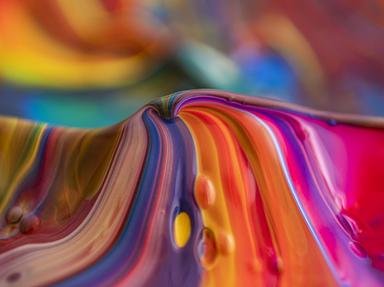Quiz Answer Key and Fun Facts
1. Perhaps the most recognizable work of Japanese art in history, "The Great Wave off Kanagawa" (1830) is a woodblock print depicting three boats struggling against a giant wave. If one looks closely at the background, one can see a famous landmark. That's because this work is part of a series where every image features what?
2. Hokusai famously broadened the field of topics of ukiyo-e prints to landscapes and nature scenes. This woodblock print by him shows the original focus of the artform, portraitures of which of these Japanese groups?
3. Utilizing the new nishiki-e technique, "Tenma Bridge in Setsu Province" comes from a set in which Hokusai painted several Japanese bridges. This scene shows spectators on a bridge watching ships pass by during the Tenjin festival. In which port city does the festival take place?
4. "Fine Wind, Clear Morning" (c. 1830-1832) depicts Japan's famous Mount Fuji on a clear morning with a calm southerly wind. In these exact conditions, the rising sun can give the mountain a distinct appearance. Because of that, what is this painting nicknamed?
5. Hokusai's ukiyo-e series "One Hundred Ghost Stories" depicts various ghosts and other supernatural beings, coming from different sources. This kabuki character is named Oiwa, the wife of a samurai who is killed and haunts her husband, coming back as what?
6. "Kajikazawa in Kai Province" (c. 1830-1832) depicts the daily life of a Japanese worker in the small town of Kajikazawa. What was the occupation of the worker?
7. For this woodblock print dated from 1831-1833, Hokusai traveled to Kurokami Mountain in Shimotsuke. What was he trying to capture in the print?
8. One of his rarer woodblocks, "Whaling Off Goto" can be found in which of Hokusai's series?
9. Paired with another painting that complements it, the waves in this work by Hokusai are meant to show peacefulness and accommodation while the waves in his other painting represent vigor and adventurousness. What are the two opposing wave paintings meant to be depicting?
10. Hokusai painted "Tiger in the Snow" only a few months before his death. He had taken to painting several "shishi," or imperial guardian lions, which many art historians believe may be connected to his late-in-life obsession with longevity. However, it wasn't a woodblock. On what medium did Hokusai paint this work?
Source: Author
trident
This quiz was reviewed by FunTrivia editor
ponycargirl before going online.
Any errors found in FunTrivia content are routinely corrected through our feedback system.
